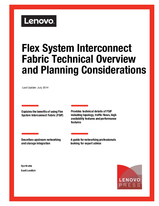Abstract
To respond to the pressures of change in today’s business environment, organizations need more flexible and cost-effective IT infrastructures. Many are taking a new approach by consolidating and virtualizing IT resources, such as servers, storage, networks, and even desktops. As the data center evolves, however, data center managers face new challenges. They must manage and control virtualization sprawl and ensure the security of the increasing number of virtual machines (VMs). In addition, they must address technology constraints while migrating workloads and determine how to manage a network infrastructure that cannot scale with the explosion of network traffic brought about by the consolidation of workloads in virtualized environments.
This Lenovo Press paper describes the key factors that are driving changes in a data center design approach, and how Flex System® Interconnect Fabric, the new data center networking (DCN) fabric solution, helps transform a data center into a scalable, manageable, and easy to deploy environment.
This paper is intended for networking IT professionals who want to learn more about Flex System Interconnect Fabric, the most recent addition to the Lenovo portfolio of DCN technologies and building blocks.
Table of Contents
Data center networking overview
Introduction to Flex System Interconnect Fabric
Flex System Interconnect Fabric components
Flex System Interconnect Fabric technical details
Point of delivery network integration
Point of delivery storage integration
Point of delivery management
Appendix: Example Interconnect Fabric POD bill of materials
Related product families
Product families related to this document are the following:

